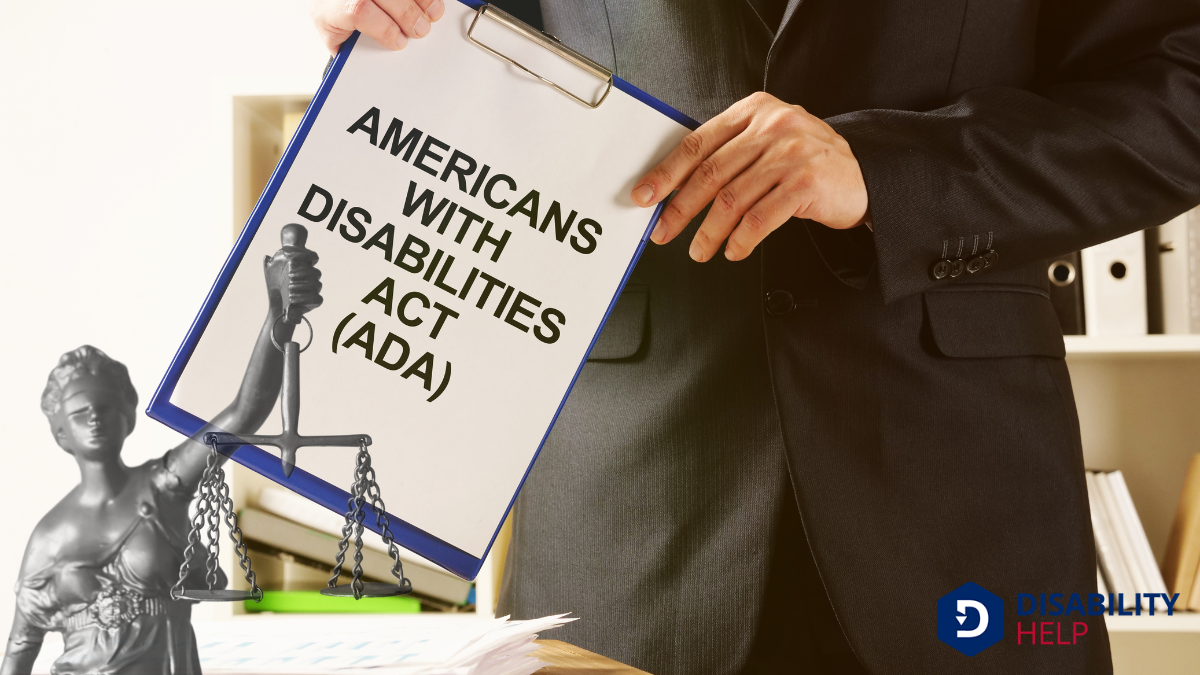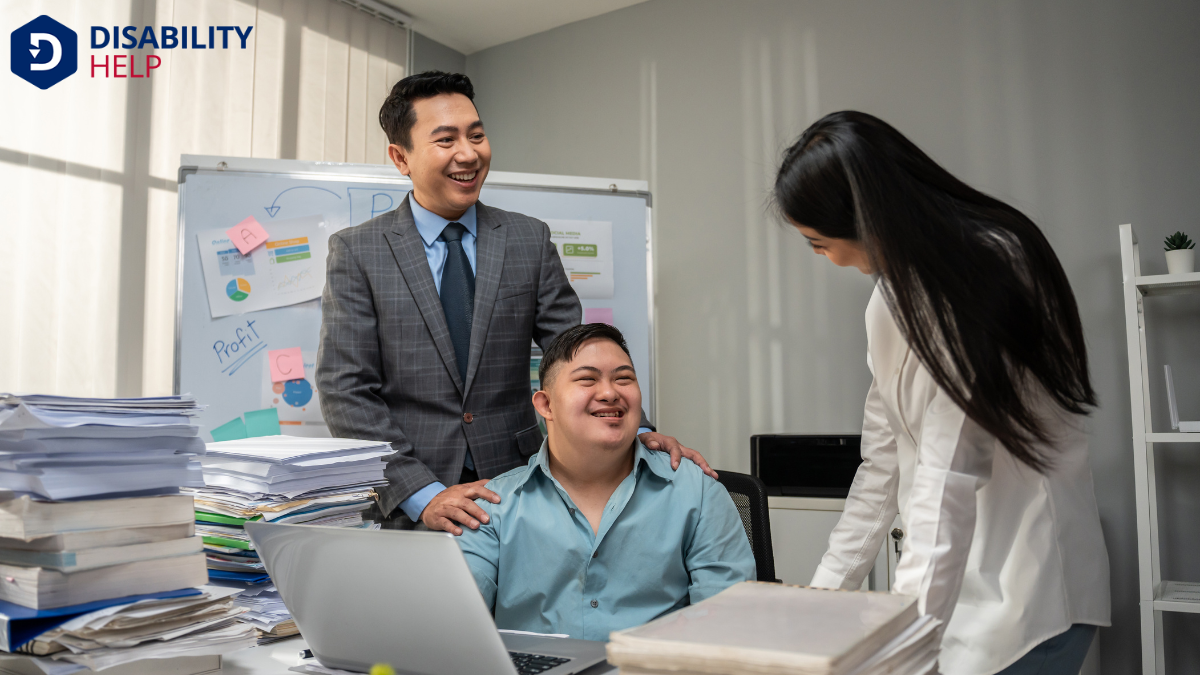We can't be fired simply for having a disability, as we're protected by the Americans with Disabilities Act (ADA)A U.S. law that prohibits discrimination against individuals with disabilities in all areas of publi.... This law guarantees we're treated fairly throughout the employment process, from hiring to promotions. Employers are also required to provide reasonable accommodationsModifications or adjustments in healthcare settings to support patients with disabilities. that allow us to perform our jobs effectively, unless it causes undue hardshipA legal concept that refers to significant difficulty or expense imposed on an employer or service p.... Understanding our rights under the ADA helps us recognize and challenge any unfair treatment, and explore more about our rights and strategies for advocacyThe act of arguing in favor of, supporting, or defending the rights and interests of individuals or ... ahead.
Key Takeaways
- The Americans with Disabilities Act (ADA) prohibits firing employees solely because of their disability.
- Employers must provide reasonable accommodations unless it causes undue hardship to the business.
- Documentation of discriminatory incidents strengthens claims if termination seems based on disability.
- Consult legal assistance or the EEOC if termination appears to violate ADA protections.
- Open communication with employers about accommodations can prevent misunderstandings leading to unlawful termination.
Understanding Disability Discrimination in the Workplace
How do we recognize disability discriminationUnfair treatment of individuals based on their disability in areas such as employment, education, an... in the workplace? We start by identifying unequal treatment towards individuals with disabilities, especially when it affects their employment status, job assignments, or growth opportunities.
Sometimes, discrimination is overt, like a manager making derogatory comments about someone's disability. Other times, it's subtle, like consistently overlooking an employee with a disability for promotions without valid reasons.
We must also note that reasonable accommodations aren't provided, making it difficult for a person with a disability to perform their job effectively.
It's essential for us to understand these signs so we can address and prevent discrimination. By fostering inclusivity and respect, we create an environment where everyone can thrive, regardless of their abilities.
Let's work together to build a fair workplace.
Legal Protections Under the Americans With Disabilities Act (ADA)

Recognizing discrimination is only one part of the puzzle; we must also understand the legal protections in place. The Americans with Disabilities Act (ADA) is a key piece of legislation that shields us from unfair treatment.
Here's how it works:
- Employment Protection: The ADA prohibits discrimination based on disability in all employment practices, including hiring, firing, and promotions.
- Equal Opportunity: Employers must provide equal opportunities to qualified individuals with disabilities, ensuring a fair playing field.
- Privacy Safeguards: The ADA restricts employers from inquiring about our disabilities unless it directly relates to job requirements.
Reasonable Accommodations and Employer Obligations
While understanding our rights under the ADA is vital, it's equally important to know about the reasonable accommodations employers are obligated to provide.
These accommodations are adjustments or modifications that enable us to perform our jobs effectively despite our disabilities. Employers should engage in an interactive process to identify what accommodations might be necessary. These can range from modifying work schedules to altering workspace setups.
Our employers aren't required to provide accommodations that would cause undue hardship, meaning significant difficulty or expense.
However, they must explore all reasonable options. If we believe our needs aren’t being met, it's important to communicate openly with our employer about potential solutions.
Recognizing and Addressing Workplace Bias
Let's explore how we can identify bias indicators and implement inclusive practices in our workplaces.
By being aware of subtle signs of discrimination, like unfair treatment or exclusion, we can address these issues head-on.
Together, we can foster an environment where everyone feels valued and respected.
Identifying Bias Indicators
How can we spot bias indicators in the workplace that signal discrimination against individuals with disabilities? Recognizing these indicators helps us create a more inclusive environment.
Let’s consider key signs:
- Unequal Opportunities: If we notice that employees with disabilities aren’t receiving the same opportunities for advancement or training as others, this may indicate bias.
- Exclusion from Activities: When colleagues with disabilities are excluded from meetings or social events, it suggests a lack of inclusionThe practice of creating environments in which any individual or group can be and feel welcomed, res... and potential discrimination.
- Inappropriate Comments: Pay attention to insensitive jokes or remarks about disabilities. Such language reflects underlying bias and can contribute to a hostile work environment.
Implementing Inclusive Practices
Recognizing bias indicators is just the start; we must also actively foster an inclusive workplace. It's crucial we create an environment where everyone feels valued and respected regardless of their abilities.
We can begin by educating ourselves and others about disabilities, guaranteeing our policies promote inclusivity and accessibilityThe design of products, devices, services, or environments to be usable by people with disabilities..... Let's advocate for open communication, where employees can express their needs without fear of judgment or retaliation.
We also need to make sure our hiring practices are fair, emphasizing skills and potential over preconceived notions. By providing training sessions focused on diversityThe inclusion of individuals from a wide range of backgrounds, including people with disabilities. and inclusion, we can dismantle stereotypes and build empathyThe ability to understand and share the feelings of another, particularly important in understanding....
It's important to regularly review our progress, seeking feedback and making necessary adjustments. Together, we can create a workplace that truly embraces diversity.
Filing a Disability Discrimination Claim

Filing a disability discrimination claim is a critical step if you believe you've been unjustly treated at work due to your disability. Understanding the process helps us navigate it more effectively.
Here's a concise guide to get started:
- Document Everything: Keep records of incidents, including dates, times, and witnesses. This documentation strengthens our claim and provides a clear timeline of events.
- Consult an Attorney or Advocate: Legal professionals or advocacy groups can offer guidance tailored to our situation. They help us understand our rights and the strength of our case.
- File with the EEOC: Contact the Equal Employment Opportunity Commission. Filing a charge initiates an investigation into our discrimination claim, which is a necessary legal step before pursuing further action.
Taking these steps empowers us to seek justice.
Real-Life Scenarios: When Termination Is Considered Unlawful
Why do some terminations cross the line into unlawful territory? When an employer fires someone based solely on their disability, it violates the Americans with Disabilities Act (ADA).
Imagine a scenario where we're performing our job duties effectively, but our employer still decides to terminate us after learning about our disability. This action isn't just unfair; it's illegal.
Let's consider another example: if reasonable accommodations were requested and denied without a legitimate reason, leading to termination, the law is on our side.
Employers must engage in an interactive process to explore accommodations. When they fail to do so and terminate us instead, it crosses into unlawful territory.
We must understand these scenarios to recognize when termination is legally questionable, ensuring our rights are protected.
How to Advocate for Your Rights in the Workplace
As we navigate our workplaces, it's essential to understand our legal protections to guarantee we're treated fairly.
We should communicate our needs clearly to our employers, making certain they know how best to support us.
Let's also document any instances of discrimination, as having a record will strengthen our case if we need to take further action.
Know Your Legal Protections
Understanding our legal protections is essential when advocating for our rights in the workplace, especially if we've a disability.
Let’s explore key areas that empower us:
- Americans with Disabilities Act (ADA): This law prohibits workplace discriminationUnfair treatment of employees based on disability, including hiring, promotion, job assignment, term... based on disability and requires employers to provide reasonable accommodations.
- Equal Employment Opportunity Commission (EEOC): We can file a complaint with the EEOC if we believe our rights under the ADA have been violated. They investigate and enforce disability discrimination laws.
- State-Specific Laws: Many states offer additional protections beyond federal laws.
Familiarizing ourselves with these can provide greater security and understanding of our rights.
Communicate Your Needs Clearly
How can we guarantee our needs are understood in the workplace? We must communicate them clearly.
Let’s start by identifying what accommodations we require and why they’re vital for our success. It’s important to approach our employers with a solution-oriented mindset, explaining how these adjustments can benefit both us and the organization. We should prepare to discuss specific examples or situations where these needs become critical.
When we communicate, let’s be concise and direct, using language that focuses on mutual understanding. It can also help to ask questions to confirm that our message is received accurately.
Document Any Discrimination
When we face workplace discrimination, it’s essential to document every incident meticulously. By keeping a detailed record, we not only protect our rights but also strengthen our case if we need to address the issue formally.
Here’s how we can do it:
- Date and Time: Note when each discriminatory incident occurs. This helps establish a pattern and provides context.
- Details of the Incident: Describe what happened, who was involved, and any specific language or actions used. Be as precise as possible.
- Impact: Record how the incident affected us personally or professionally, whether it’s emotional distress or missed opportunities.
Seeking Support and Resources for Employees With Disabilities

Maneuvering the workplace with a disability can be challenging, but there are numerous resources and support systems available to ensure we thrive professionally.
First, let's connect with our company's human resources department. They can provide information on workplace accommodations and assure our rights are respected.
Additionally, we should explore employee resource groups designed for individuals with disabilities. These groups offer a sense of community and valuable networking opportunities.
Outside our workplace, organizations like the Job Accommodation Network (JAN)A U.S. service that provides free, expert, and confidential guidance on workplace accommodations and... and the Equal Employment Opportunity Commission (EEOC) can offer guidance on rights and accommodations.
Online forums and advocacy groups also provide spaces to share experiences and advice. By tapping into these resources, we empower ourselves to navigate challenges and build fulfilling careers despite any obstacles.
Conclusion
In summary, we must remember that as employees with disabilities, we have rights and protections under the ADA. It’s vital to recognize when workplace bias occurs and to understand how to address it effectively. By advocating for our rights and seeking necessary accommodations, we can create a more inclusive work environment. If discrimination occurs, we shouldn’t hesitate to file a claim and seek support from available resources to guarantee fair treatment.






